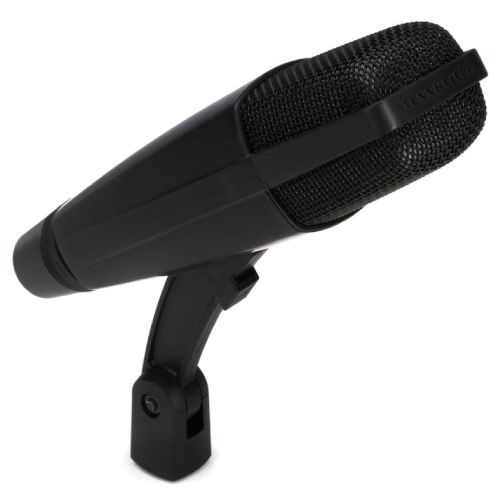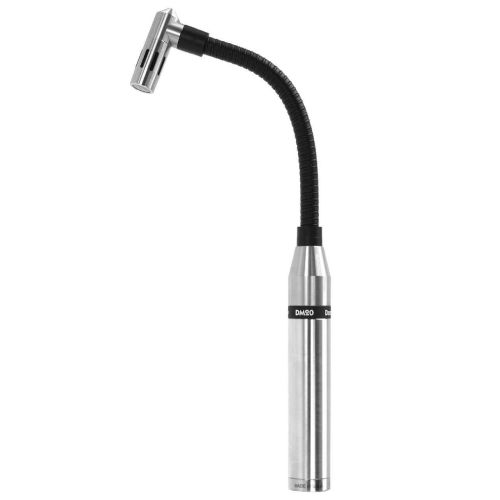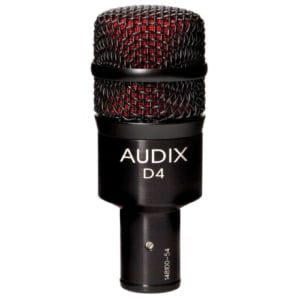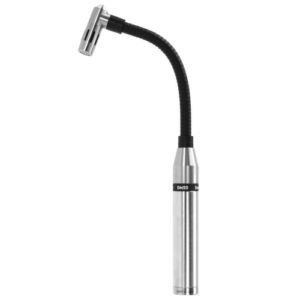I review products independently and only recommend products I would use myself. If you purchase through a link, I may earn an affiliate commission. Learn more.
Floor toms are the deepest toms in a drum kit setup, and they produce booming tones that are both thick and powerful. To pick those sounds up in a drum mix, you need a decent microphone that can easily handle lower frequencies.
While any mic would work relatively well, not all of them bring out the beefiness that you want from a floor tom.
I’ve picked out five of the best microphones on the market that can be used for floor toms. I’ve compared them according to their sound quality, ability to pick up bass frequencies, value, and their overall performance.
What are the Best Floor Tom Microphones?
In-Depth Floor Tom Microphone Reviews
Sennheiser MD 421-II Cardioid Dynamic Microphone
Sennheiser MD 421-II Cardioid Dynamic Microphone Review
This wouldn’t be a good floor tom mic list without mentioning the Sennheiser MD 421. This microphone has an incredibly good reputation in the music industry, as it regularly gets used for various types of bass-heavy instruments.
It’s an excellent option for floor toms, as it includes features that highlight bass tones to give you a big and booming tom sound in your mix.
The cardioid pattern offers good bleed rejection, meaning this mic will barely pick up the sounds of the other drums or cymbals around it.
The mic also has a five-position bass roll-off switch, which you can heavily utilize when placing it on a floor tom. The different positions offer various levels of bass boost, so you can play around with it to get your preferred bass tone from your floor tom.
The final thing worth mentioning is that this microphone can handle exceptionally high sound pressure levels, so heavy drummers will have no clipping or distortion issues when they play the floor tom really hard.
This is undoubtedly one of the best microphones that you can use on a floor tom, making it an easy choice for anyone willing to pay for it. Note that it’s a bit pricey compared to the other options we’re going to look at.
Also, the casing isn’t as durable as it should be. It’s a bit of a known fact in the music world that you need to be very careful with your placement on a drum kit. A few stray drumstick shots may damage the body.
Features:
- 30Hz – 17kHz frequency response
- Internal bass tubes
- Five-position bass roll-off switch
Pros
- One of the most popular and reliable options for floor toms
- Warm sounds with plenty of snap
- Easily projects the low tones of a floor tom
- Common option for professional recording studios
Cons
- The casing isn’t as durable as drummers would like it to be, so you need to make sure it’s safely positioned
- My most expensive suggestion for this list
Sennheiser e 604 Cardioid Dynamic Drum Microphone
Sennheiser e 604 Cardioid Dynamic Drum Microphone Review
The Sennheiser e 604 is quite a small microphone that comes with a clip to mount onto a rim. It was designed specifically for drums, especially rack toms and floor toms.
It’s one of the more affordable drum microphones available, so it’s an excellent choice for drummers looking to save on costs.
Even though it’s relatively inexpensive, it has top-quality performance quality. It does a great job of capturing the attack of a floor tom. It does an even better job of capturing sustain, leaving you with a powerful and resonating tom sound in your mix.
One of my favorite aspects of this mic is its size. It’s quite small, so you can position it in several different ways without worrying about it getting in the way when you play.
The included rim mount is also very solid. It has a simple design, but it’s a reliable one that makes mounting the e 604 quick and painless.
This microphone sounds quite similar to a Shure SM57. However, the faster transient response makes it a bit cleaner with slightly richer sounds, making this the better mic to use on a floor tom.
With that said, the sound quality isn’t as good as what you’d get from a larger and more refined microphone. So, you may want to look for something superior if you want more control over how your floor tom sounds in a mix.
Features:
- 40Hz – 18kHz frequency response
- Advanced shock mount
- Sound pressure level handling up to 160 dB
Pros
- Surprisingly good audio quality for such a small microphone
- Easy to place on a floor tom without it getting in the way
- Designed specifically for drums, so it’s easy to work with when getting a drum mix
- Solid rim mount design
Cons
- Sound quality isn’t as rich or detailed as what you get from higher-end mics
Audix D4 Hypercardioid Dynamic Instrument Microphone
Audix D4 Hypercardioid Dynamic Instrument Microphone Review
Audix makes some of the best microphones for drum kits. Like Shure, the brand has a decently large range of mics that are regularly used for both live and studio settings. This makes Audix an easy brand to choose, as most drummers praise the mics for their reliability.
The Audix D4 is one of the few microphones on the market that has been designed specifically for floor toms. While other brands offer mics that work for all toms, Audix gives you the D2s for rack toms and the D4s for floor toms.
The mic has been created to highlight the lower frequencies that floor toms produce, giving you powerful sounds with a significant thump every time you strike the drum.
Another thing that drummers commonly praise this mic for is its reliability in different environments. You can get very similar sounds in your mix, no matter what room or stage you’re playing on.
This is fantastic for when you try to recreate the mix that you got in your practice room to bring it to a stage.
This mic is quite similar to the Sennheiser e 604, with the drawback being that it’s slightly larger. This makes it trickier to place in a position where you can’t hit it with your drumsticks.
Features:
- 40Hz – 18kHz frequency response
- Hypercardioid polar pattern
- Sound pressure level handling up to 144 dB
Pros
- Highly reliable sound quality, no matter what environment you use the microphone in
- Quite easy to mix with
- Gives a powerful thumping sound from your floor tom
- Inexpensive
Cons
- A bit larger than the Sennheiser e 604, so it’s harder to place comfortably
Earthworks DM20 Small-Diaphragm Condenser Drum Microphone
Earthworks DM20 Small-Diaphragm Condenser Drum Microphone Review
The Earthworks DM20 has become increasingly popular over the last few years. With Earthworks being one of the most notorious brands to get top-quality mics from, you can be sure that this one will make your floor tom sound amazing.
The big difference between this mic and all the others on this list is that it’s a condenser instead of a dynamic microphone. This means that it has a wider pickup range, but most importantly, the quality of sound you get is a bit richer.
Earthworks has also done a great job of ensuring that this microphone rejects a lot of bleed, which is why it works so well as a snare or tom microphone.
One of its best features is how accurate it is. The sound you get in the mix will be exactly how your floor tom sounds in the room. You can then mix and EQ it to get whatever sounds you’re looking for.
I also love the gooseneck design. This microphone is bigger than a lot of people initially assume, but the body clips to the side of your floor tom while the gooseneck allows you to position the mic’s head.
Just keep in mind that it’s quite expensive.
Features:
- 50Hz – 20kHz frequency response
- 150dB sound pressure level
- Gooseneck design
Pros
- Gooseneck design makes it very easy to position and change position whenever needed
- Incredibly accurate recreation of how your floor tom sounds in the room
- Pristine build quality
- Versatile enough to be used in multiple ways around a drum set
Cons
- Quite expensive
- Condensers are a bit trickier to use as close mics, so you need to be careful with positioning
AKG D112 MKII Cardioid Dynamic Kick Drum Microphone
AKG D112 MKII Cardioid Dynamic Kick Drum Microphone Review
The AKG D112 is a unique option, as it’s mainly intended to be used as a bass drum microphone.
However, you can attach it to a heavy microphone stand and direct it at your floor tom to give you highlighted bass tones.
This mic allows you to get seriously thick and heavy floor tom sounds, making it excellent for drummers that like a powerful low end punch.
The low-frequency response is unmatched when comparing it to the other mics on this list. You can then use it for your bass drum at stages where you don’t need it for a floor tom.
Another thing to mention is that the durability is incredibly good. This mic is thick and heavy, and it will most likely last decades without showing any signs of slowing down.
It just isn’t great for drummers that want a more balanced floor tom sound.
Features:
- 20Hz – 17kHz frequency response
Pros
- Versatile enough to be used for both floor toms and bass drums
- Allows you to get a deeper floor tom sound than most other mics
- Incredibly durable
Cons
- Not great for drummers that want mid and high frequencies from their floor tom
Floor Tom Microphone Buying Guide
While overhead, kick drum, and snare drum microphones are arguably more important to get, having a high-quality floor tom mic will add a lot of depth to your drum mix.
If you get a good microphone that handles low frequencies well, you’ll be able to beef your drum kit sound up quite easily, and this will lead to an overall more powerful mix.
There are plenty of good microphones out there, with many of them offering slightly different qualities. Some mics bring out excellent natural sounds, while others enhance the tones a bit, sounding sharper and more refined.
If you’re inexperienced with using mics, these qualities can be tricky to understand.
So, here are a few things to consider when comparing different drum mics for floor toms.
Features to Look Out for in a the Best Tom Mics for Floor Toms
Frequency Range
A frequency response range refers to the range of sounds that a microphone can pick up and accurately push out. Every microphone has a range, and you should be looking for ones with ranges on the lower side when looking for floor tom mics.
With floor toms producing low-pitched sounds most of the time, you want a microphone that can accurately record those. It should also give you a good amount of control to allow you to alter the sounds when you’re mixing.
Pickup Patterns
Pickup patterns determine how microphones perform. The main ones are cardioid, supercardioid, and hypercardioid.
Cardioid is the most common polar pattern, and it refers to microphones that pick up sound from the front. So, these need to be directly facing your floor tom.
You’ll get a slight bit of bleed from these mics, but it’s never anything to worry about. Some sound engineers even like it.
Supercardioid reject more bleed, so you get a more focused sound from your floor tom.
Hypercardioid mics reject even more, giving you the most isolated floor tom sound possible.
All three of these polar patterns have their place, so it’s up to you on which microphone you decide to get depending on what pickup pattern it has.
Rim Clip Design
Some floor tom microphones have dedicated rim mount clips, while others need to be attached to microphone stands.
The ones that come with rim mounts are far more convenient to use, as they take up less space and they’re very easy to place.
If a mic doesn’t have a drum rim clip, you could possibly buy one separately to attach it to. Other mics are too big to use with rim clips, so you have no choice but to put them on a mic stand.
It’s fine to have a mic stand if you have the space for it, but there are some situations where having a dedicated mic stand for your floor tom isn’t possible. You’d need to use a different kind of microphone.
Accessories
You should also check what accessories come with a microphone. Most mics will come with a bag to put them in, but you may also get things like pop filters and foam windscreens.
If you buy a more expensive floor tom microphone, it’s likely to come with a few extra accessories to either keep as collectibles or help set the mic up.
Floor Tom Microphone FAQs
Should You Mic the Bottom of a Floor Tom?
You can get a fantastic floor tom sound without placing a microphone near the bottom drumhead. Most drummers and live sound engineers don’t use two mics for floor toms.
You’ll mostly see it happening in professional recording studios, as the second microphone gives you a lot more control over how the floor tom sounds in the mix. If you want as much control as possible, then adding a second floor tom mic will definitely help.
How Important are Floor Tom Microphones?
They’re important, but they’re not as important as overheads or kick drum microphones. If you’re limited to the number of mics that you can use on your drum set, you should first use overhead mics to pick up the entire sound of the kit and a kick mic to get a focused bass drum sound.
You can then argue that a snare drum mic is the next important option, with a floor tom mic following after that.
What’s the Best Floor Tom Microphone for Live Gigs?
There are dozens of good options out there, with all of them offering excellent performance quality. While there’s no final answer to this, the Sennheiser MD 421 is one of the most popular microphones that sound engineers like to use for floor toms.
This microphone is often referred to as an industry-standard option, as it’s been one of the go-to mics for several years.






















